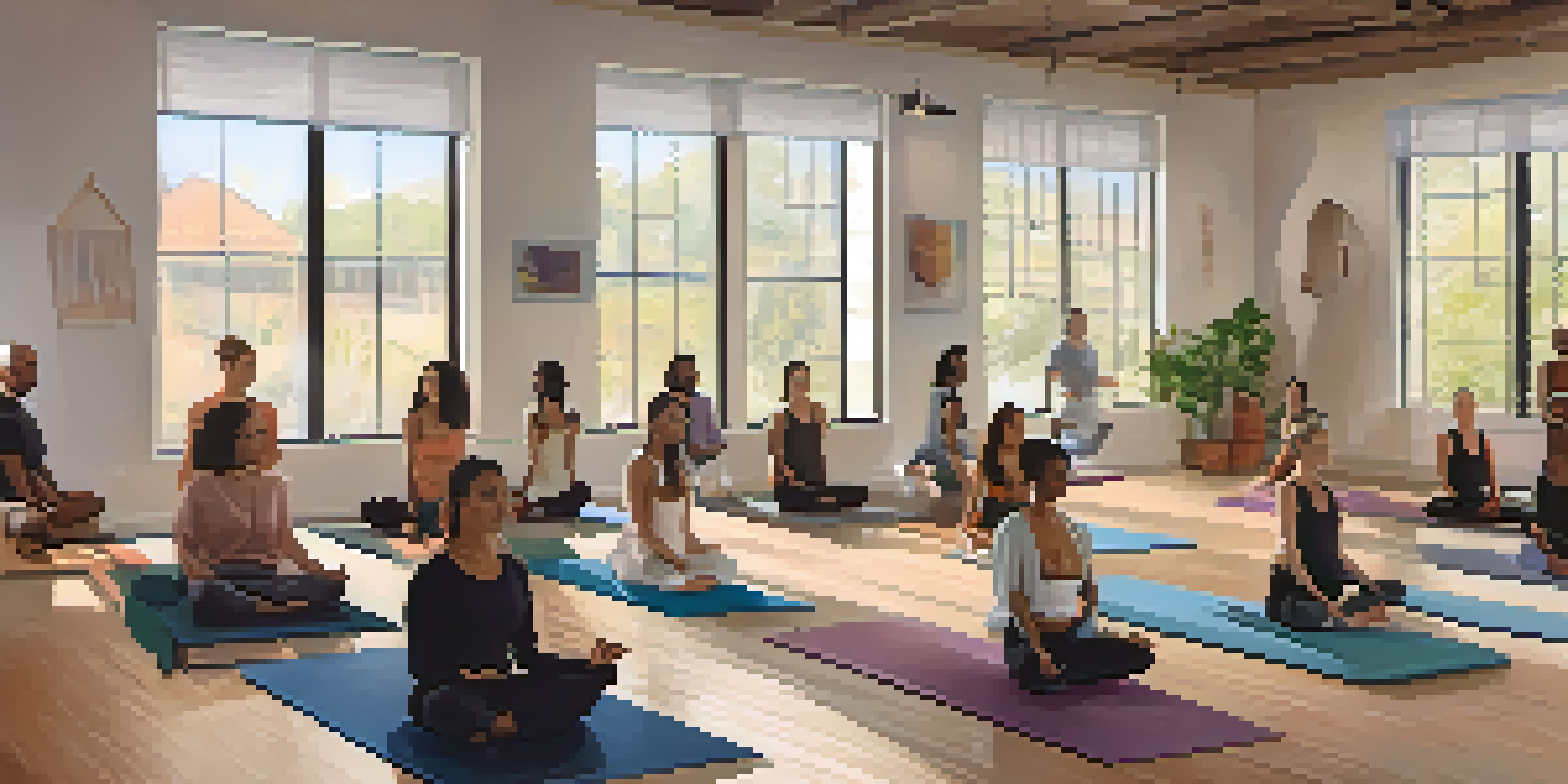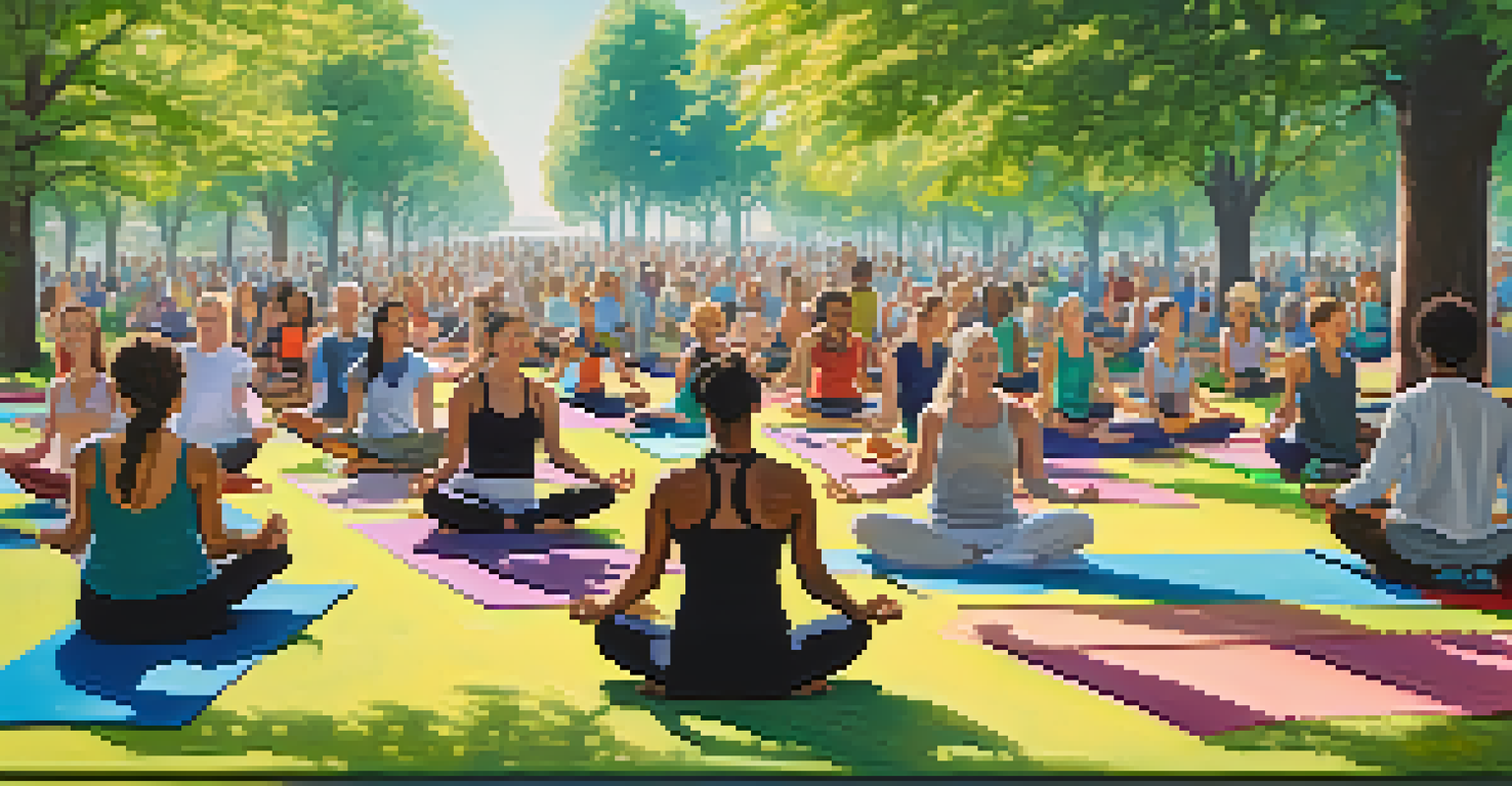Creating Safe Spaces: Yoga for Vulnerable Communities

Understanding Safe Spaces in Yoga
A safe space is an environment where individuals can feel secure and supported, especially those from vulnerable communities. In yoga, this concept is crucial as it allows practitioners to explore their physical and emotional boundaries without fear of judgment. Imagine a cozy room filled with soft lighting and calming scents, where everyone can be their true selves and connect on a deeper level.
Yoga is not about touching your toes, it’s about what you learn on the way down.
Creating these spaces involves not just the physical setting but also the attitude and approach of the instructor. A welcoming teacher can make all the difference, offering guidance while ensuring that everyone feels included and valued. This sense of belonging can be especially empowering for those who have faced exclusion in other areas of their lives.
Ultimately, safe spaces in yoga are about fostering trust and openness. They encourage individuals to express themselves freely, paving the way for personal growth and healing. This foundation is essential for vulnerable communities seeking solace and strength through yoga.
The Benefits of Yoga for Vulnerable Communities
Yoga offers a myriad of physical and mental health benefits, particularly for vulnerable populations. From improving flexibility and strength to reducing anxiety and stress, the practice can be transformative. Think of it as a gentle balm for the body and mind, helping individuals navigate their daily challenges more effectively.

For marginalized groups, yoga can serve as a powerful tool for empowerment and self-advocacy. It encourages participants to listen to their bodies, fostering a sense of autonomy and self-awareness that can extend beyond the mat. This newfound confidence can inspire individuals to advocate for themselves in various aspects of their lives, from healthcare to social justice.
Safe Spaces Enhance Yoga Experience
Creating safe spaces in yoga allows individuals to explore their boundaries without fear of judgment, fostering personal growth and healing.
Moreover, group yoga sessions can cultivate a sense of community and support among participants. The shared experience of practicing together can create bonds that help individuals feel less isolated. This connection is particularly vital for those who may not have access to other community-building opportunities.
Tailoring Yoga Practices for Diverse Needs
Not all yoga practices work for everyone, especially in diverse communities. It’s essential to adapt classes to meet the unique needs of participants, whether they are dealing with physical limitations, trauma, or cultural differences. Envision a class where every posture is accessible, and modifications are encouraged, allowing everyone to participate fully.
The ultimate aim of yoga is to reach the state of liberation or nirvana, where we feel a sense of oneness with everything and everyone around us.
Instructors should be trained to recognize and address these variations, creating an inclusive environment. For example, offering props or alternative poses can help those with mobility challenges feel engaged without feeling excluded or overwhelmed. This flexibility not only supports physical participation but also honors the diverse backgrounds of the individuals in class.
Additionally, incorporating elements from different cultural practices can enrich the yoga experience. This could involve blending traditional yoga techniques with local customs or mindfulness practices, fostering a deeper connection among participants. It’s about celebrating diversity while creating a unified space for healing and growth.
Building Community Through Yoga
Yoga has a unique ability to bring people together, creating a sense of community among participants. When individuals practice together, they share not just the physical space but also their stories and experiences. This communal aspect can be especially powerful for those from vulnerable backgrounds, as it fosters connection and understanding.
Community-building in yoga can take many forms, from group discussions to shared goals. Instructors can facilitate conversations that allow participants to reflect on their journeys and support one another. Imagine a circle of individuals sharing their challenges and triumphs, creating a tapestry of resilience and hope.
Yoga Empowers Vulnerable Communities
Yoga serves as a transformative tool for vulnerable populations, promoting self-advocacy, autonomy, and community support.
Ultimately, these connections can extend beyond the yoga mat, leading to lasting friendships and support networks. Participants may find themselves reaching out to one another outside of class, collaborating on initiatives or simply checking in on each other’s well-being. This sense of belonging can be life-changing for many.
Overcoming Barriers to Participation
While yoga has many benefits, there are often barriers that prevent vulnerable communities from participating. Financial constraints, lack of transportation, or even cultural misconceptions about yoga can pose significant challenges. It’s important to address these hurdles to ensure that everyone has access to the healing power of yoga.
Offering free or low-cost classes can be an effective way to reduce financial barriers. Community centers and local organizations can partner with yoga instructors to create accessible programs that welcome all. Imagine a class held in a neighborhood park, where individuals can practice together without worrying about costs.
Additionally, outreach and education can help demystify yoga for those who may feel intimidated. Workshops that explain the basics of yoga and its benefits can encourage hesitant individuals to give it a try. By actively engaging the community and addressing their concerns, we can break down these barriers and promote inclusivity.
The Role of Instructors in Creating Safe Spaces
Instructors play a pivotal role in establishing safe spaces within yoga classes. Their approach, language, and demeanor can significantly influence how participants feel and engage with the practice. A compassionate instructor who prioritizes empathy and understanding can make a world of difference for vulnerable individuals.
It's essential for instructors to receive training in trauma-informed practices, which can help them recognize and respond to the unique needs of their students. This training empowers teachers to create an environment where participants feel safe to explore their physical and emotional boundaries without fear. Consider how a well-prepared instructor can transform a class into a sanctuary of healing.
Inclusivity is Key in Yoga Practices
Tailoring yoga practices to diverse needs ensures that everyone can participate fully, enhancing both physical engagement and cultural connection.
Moreover, instructors should actively seek feedback from participants to continuously improve their classes. This open line of communication fosters trust and allows instructors to adjust their teaching styles to better meet the needs of their communities. When participants feel heard and valued, they are more likely to return and engage in their yoga practice.
Promoting Inclusivity Through Yoga Events
Hosting yoga events focused on inclusivity can be an excellent way to engage vulnerable communities. These events can vary from community yoga days in parks to workshops that specifically address the needs of marginalized groups. Picture a vibrant gathering where individuals of all backgrounds come together to practice and celebrate their diversity.
Such events can also serve as platforms for education and awareness, highlighting the importance of mental and physical wellness. By inviting guest speakers or featuring local wellness resources, organizers can provide valuable information to participants. This holistic approach empowers individuals to take charge of their well-being.

Moreover, promoting these events through community channels ensures that they reach those who might benefit most. Flyers, social media posts, and word-of-mouth can all play a role in spreading the word. By actively engaging the community and encouraging participation, we can create a ripple effect of healing and connection through yoga.